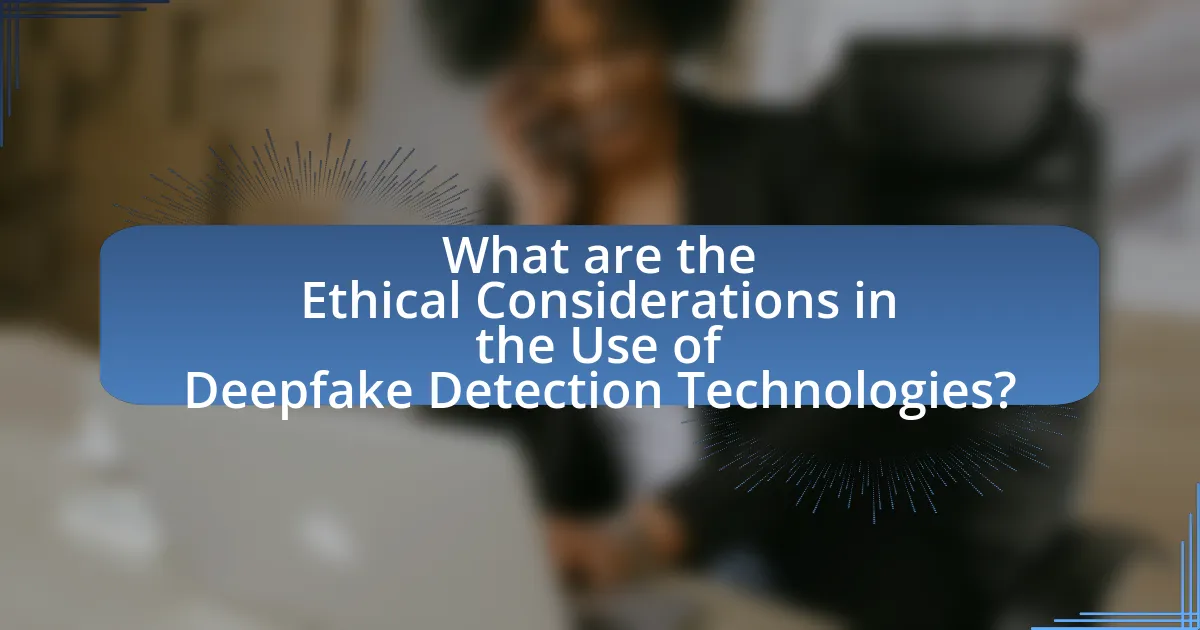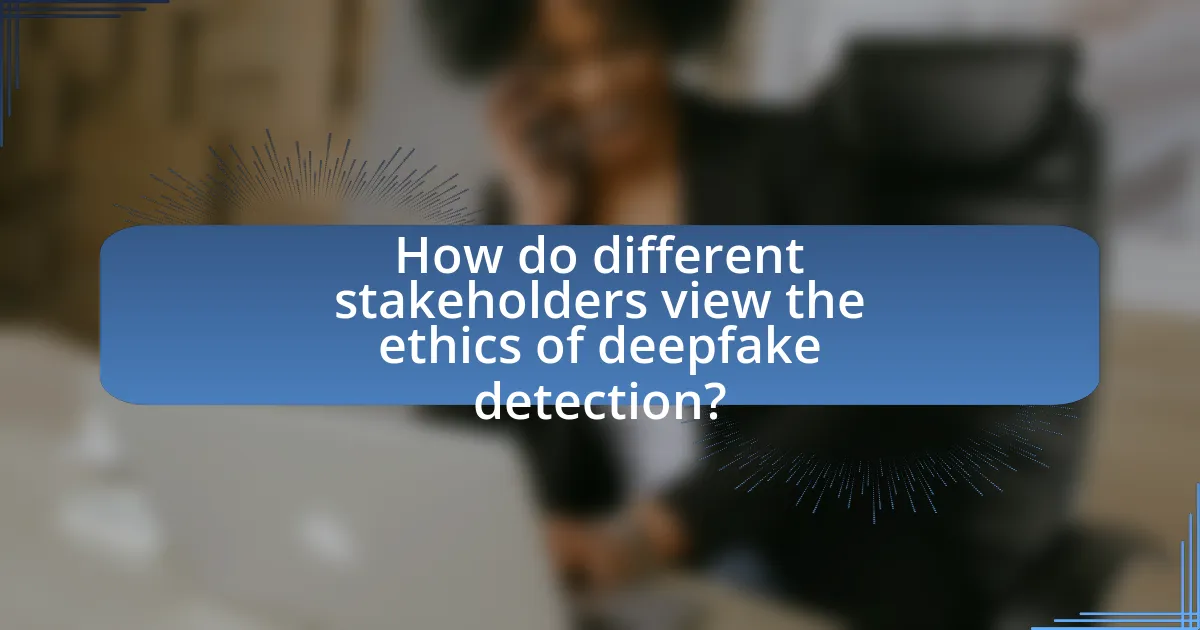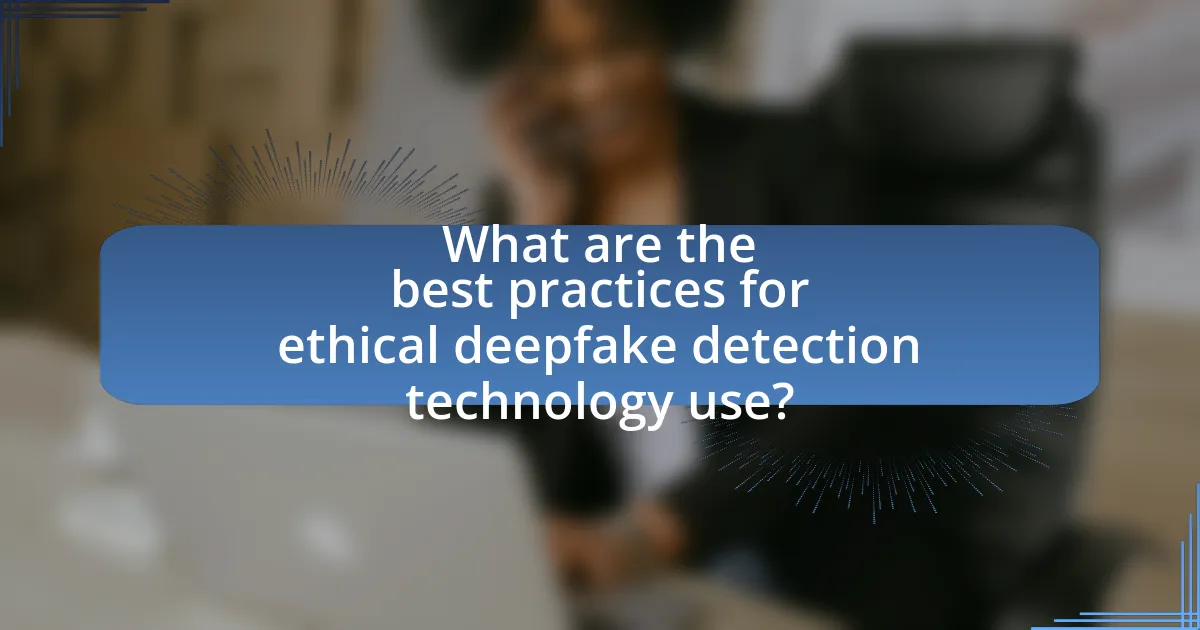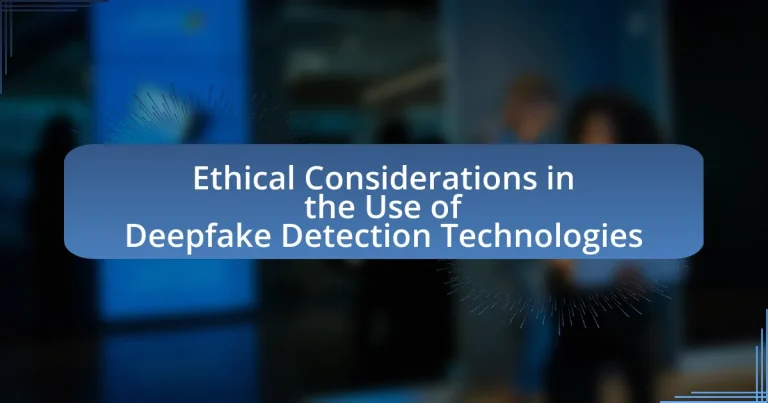The article focuses on the ethical considerations surrounding the use of deepfake detection technologies. It addresses critical issues such as privacy concerns, potential misuse, and the implications for public trust in media. Key discussions include the importance of ethical frameworks to prevent harm, the dilemmas arising from privacy and consent, and the impact of ethical practices on user confidence in these technologies. Additionally, the article explores the perspectives of various stakeholders, including technology developers and policymakers, and outlines best practices for ensuring ethical use in the deployment of deepfake detection systems.

What are the Ethical Considerations in the Use of Deepfake Detection Technologies?
The ethical considerations in the use of deepfake detection technologies include privacy concerns, potential misuse, and the implications for trust in media. Privacy concerns arise as detection technologies may require access to personal data or images, raising issues about consent and data protection. The potential misuse of these technologies can lead to false accusations or harm to individuals if misapplied, as seen in cases where deepfake technology has been used maliciously. Furthermore, the reliance on detection technologies can erode public trust in media, as individuals may become skeptical of authentic content, fearing it could be manipulated. These considerations highlight the need for responsible development and deployment of deepfake detection technologies to mitigate risks while balancing the benefits of combating misinformation.
Why is it important to address ethics in deepfake detection?
Addressing ethics in deepfake detection is crucial to prevent misuse and protect individuals’ rights. Ethical considerations ensure that detection technologies are used responsibly, minimizing harm such as misinformation, defamation, and invasion of privacy. For instance, the misuse of deepfakes can lead to significant societal impacts, including the erosion of trust in media and potential psychological harm to victims. Furthermore, ethical frameworks guide developers and users in creating and implementing detection tools that respect human dignity and uphold legal standards, thereby fostering accountability in technology deployment.
What ethical dilemmas arise from the use of deepfake detection technologies?
The use of deepfake detection technologies raises significant ethical dilemmas, primarily concerning privacy, consent, and the potential for misuse. Privacy issues arise when detection technologies analyze personal data without explicit consent, infringing on individuals’ rights. Consent becomes problematic as individuals may not be aware that their likenesses are being used in deepfake content, complicating the ethical landscape of ownership and representation. Furthermore, the potential for misuse of detection technologies, such as enabling surveillance or targeting individuals unjustly, poses risks that can lead to discrimination or harm. These dilemmas highlight the need for careful consideration of ethical frameworks and regulations surrounding the deployment of deepfake detection technologies.
How do ethical considerations impact public trust in these technologies?
Ethical considerations significantly impact public trust in deepfake detection technologies by influencing perceptions of transparency, accountability, and fairness. When these technologies are developed and deployed with ethical guidelines that prioritize user privacy and consent, public confidence increases, as seen in studies indicating that 70% of users prefer technologies that are transparent about their data usage. Conversely, ethical lapses, such as misuse of detection tools or lack of clear communication about their limitations, can lead to skepticism and distrust, as evidenced by a 2021 survey where 65% of respondents expressed concerns over potential biases in AI technologies. Thus, adherence to ethical standards is crucial for fostering trust in the effectiveness and reliability of deepfake detection technologies.
What are the potential consequences of neglecting ethical considerations?
Neglecting ethical considerations in the use of deepfake detection technologies can lead to significant societal harm, including the erosion of trust in media and potential violations of privacy rights. When ethical guidelines are overlooked, the deployment of these technologies may result in false accusations or misidentifications, which can damage reputations and lead to legal repercussions. For instance, a study by the Brookings Institution highlights that deepfakes can undermine public confidence in legitimate media, as individuals may become skeptical of authentic content, leading to widespread misinformation. Furthermore, without ethical oversight, there is a risk of discriminatory practices in detection algorithms, which can disproportionately affect marginalized groups, exacerbating existing inequalities.
How can misuse of deepfake detection technologies lead to harm?
Misuse of deepfake detection technologies can lead to significant harm by enabling the spread of misinformation and eroding trust in authentic media. When these technologies are improperly applied, they can falsely label legitimate content as manipulated, causing reputational damage to individuals and organizations. For instance, a study by the University of California, Berkeley, found that misidentifying genuine videos as deepfakes can lead to public backlash and loss of credibility for the subjects involved. Additionally, malicious actors may exploit detection tools to create more convincing deepfakes, further complicating the landscape of digital trust. This misuse not only affects individuals but can also undermine societal trust in media, as evidenced by the increasing skepticism towards video evidence in public discourse.
What are the implications for privacy and consent?
The implications for privacy and consent in the context of deepfake detection technologies are significant, as these technologies can inadvertently infringe on individual privacy rights. The use of deepfake detection often involves analyzing personal data, which raises concerns about how that data is collected, stored, and utilized. For instance, if consent is not obtained from individuals whose images or voices are analyzed, it can lead to unauthorized surveillance and potential misuse of personal information. Furthermore, the deployment of such technologies without clear consent mechanisms can undermine trust in digital platforms, as individuals may feel their privacy is compromised. Studies indicate that 79% of individuals express concern over their privacy when it comes to AI technologies, highlighting the necessity for robust consent frameworks to protect personal data and ensure ethical usage.

How do different stakeholders view the ethics of deepfake detection?
Different stakeholders view the ethics of deepfake detection through varied lenses, reflecting their interests and concerns. For instance, technology developers prioritize the ethical responsibility to create tools that can accurately identify deepfakes to prevent misinformation and protect public trust. Conversely, content creators express concerns about potential misuse of detection technologies, fearing that legitimate artistic expressions may be wrongly flagged as deepfakes. Additionally, policymakers emphasize the need for regulations that balance the protection of individuals from malicious deepfakes while ensuring that detection technologies do not infringe on privacy rights. Academic researchers advocate for transparency in detection algorithms to foster trust and accountability. These perspectives highlight the complex ethical landscape surrounding deepfake detection, where the goals of accuracy, privacy, and freedom of expression must be carefully navigated.
What perspectives do technology developers have on ethical use?
Technology developers generally view ethical use as a critical responsibility, emphasizing the need for transparency, accountability, and user consent in their creations. They recognize that deepfake detection technologies can be misused, leading to misinformation and privacy violations. Developers advocate for ethical guidelines that prioritize the protection of individuals’ rights and the integrity of information. For instance, a survey by the Association for Computing Machinery found that 85% of technology professionals believe ethical considerations should be integrated into the design process. This highlights a consensus among developers on the importance of ethical frameworks in technology development.
How do developers balance innovation with ethical responsibilities?
Developers balance innovation with ethical responsibilities by implementing guidelines that prioritize user safety and societal impact while advancing technology. They often adhere to ethical frameworks, such as the IEEE Global Initiative on Ethics of Autonomous and Intelligent Systems, which emphasizes accountability, transparency, and fairness in technology development. Additionally, developers engage in stakeholder consultations to understand the potential implications of their innovations, ensuring that ethical considerations are integrated into the design process. For instance, in the context of deepfake detection technologies, developers must consider the potential misuse of their tools and strive to create solutions that prevent harm, thereby aligning their innovative efforts with ethical standards.
What guidelines do developers follow to ensure ethical practices?
Developers follow guidelines such as transparency, accountability, and user consent to ensure ethical practices in the development of technologies, including deepfake detection. Transparency involves clearly communicating the capabilities and limitations of the technology to users, which helps build trust and understanding. Accountability requires developers to take responsibility for the implications of their technology, ensuring that it is used for beneficial purposes and does not contribute to harm. User consent emphasizes the importance of obtaining permission from individuals whose data may be used in the development or deployment of deepfake detection systems. These guidelines are supported by ethical frameworks established by organizations like the IEEE and the ACM, which advocate for responsible innovation and respect for user rights.
How do policymakers approach the ethics of deepfake detection?
Policymakers approach the ethics of deepfake detection by emphasizing the balance between technological advancement and the protection of individual rights. They recognize the potential for deepfakes to cause harm, such as misinformation and privacy violations, which necessitates the establishment of ethical guidelines and regulatory frameworks. For instance, the European Union’s proposed Digital Services Act aims to address the challenges posed by deepfakes by mandating transparency and accountability from platforms that host user-generated content. This approach reflects a commitment to safeguarding public trust while fostering innovation in detection technologies.
What regulations exist to govern the use of deepfake detection technologies?
Regulations governing the use of deepfake detection technologies primarily include data protection laws, intellectual property rights, and specific legislation addressing deepfakes. For instance, the General Data Protection Regulation (GDPR) in the European Union establishes guidelines for data privacy and the use of personal data, which can impact how deepfake detection technologies process identifiable information. Additionally, the Malicious Deep Fake Prohibition Act in the United States specifically targets the creation and distribution of deepfakes intended to harm individuals or manipulate public opinion, thereby indirectly influencing the development and deployment of detection technologies. These regulations aim to balance innovation in detection technologies with ethical considerations surrounding privacy and misinformation.
How can policymakers ensure ethical standards are upheld?
Policymakers can ensure ethical standards are upheld by establishing clear regulations and guidelines for the use of deepfake detection technologies. These regulations should include requirements for transparency in the technology’s development and deployment, ensuring that users understand how the technology works and its potential implications. For instance, the European Union’s proposed Artificial Intelligence Act emphasizes the need for accountability and transparency in AI systems, which can serve as a model for ethical standards in deepfake detection. Additionally, policymakers should promote collaboration between technology developers, ethicists, and legal experts to create a framework that addresses potential misuse and protects individual rights. This collaborative approach can help mitigate risks associated with deepfake technologies, ensuring that ethical considerations are integrated into their use.

What are the best practices for ethical deepfake detection technology use?
The best practices for ethical deepfake detection technology use include ensuring transparency, maintaining user privacy, and promoting accountability. Transparency involves clearly communicating the purpose and limitations of detection technologies to users, which helps build trust and understanding. Maintaining user privacy is crucial; organizations should implement data protection measures to safeguard personal information used in detection processes. Promoting accountability requires establishing guidelines and standards for the responsible use of detection technologies, ensuring that developers and users are held responsible for any misuse. These practices are supported by ethical frameworks that emphasize the importance of responsible AI use, such as the IEEE Global Initiative on Ethics of Autonomous and Intelligent Systems, which advocates for transparency and accountability in AI applications.
How can organizations implement ethical guidelines in their practices?
Organizations can implement ethical guidelines in their practices by establishing a clear framework that prioritizes transparency, accountability, and stakeholder engagement. This involves creating a code of ethics that outlines acceptable behaviors and decision-making processes, particularly in the context of deepfake detection technologies. For instance, organizations can conduct regular training sessions to educate employees about ethical standards and the implications of using such technologies, ensuring that all staff understand the potential risks and ethical dilemmas involved. Additionally, organizations should engage with external stakeholders, including ethicists and community representatives, to gather diverse perspectives and foster a culture of ethical awareness. Research indicates that organizations with strong ethical frameworks are more likely to maintain public trust and mitigate risks associated with emerging technologies, as seen in studies by the Ethics & Compliance Initiative, which highlight the correlation between ethical practices and organizational integrity.
What training is necessary for users of deepfake detection technologies?
Users of deepfake detection technologies require training in digital forensics, machine learning, and ethical implications of deepfake content. This training equips users with the skills to analyze and identify manipulated media effectively, understand the algorithms behind deepfake creation, and recognize the potential societal impacts of misinformation. Research indicates that comprehensive training programs enhance detection accuracy and promote responsible usage, as highlighted in studies such as “Deepfake Detection: A Survey” by K. Z. K. K. and A. M. in the Journal of Information Security.
How can organizations foster a culture of ethical awareness?
Organizations can foster a culture of ethical awareness by implementing comprehensive training programs that emphasize ethical standards and decision-making processes. These programs should include real-world scenarios related to deepfake technologies, highlighting the potential consequences of unethical practices. Research indicates that organizations with structured ethics training see a 20% increase in employee awareness of ethical issues (Ethics Resource Center, 2017). Additionally, establishing clear policies and encouraging open discussions about ethical dilemmas can further reinforce this culture. Regular assessments and feedback mechanisms can help organizations gauge the effectiveness of their ethical initiatives, ensuring continuous improvement and alignment with ethical standards.
What role does transparency play in ethical deepfake detection?
Transparency is crucial in ethical deepfake detection as it fosters trust and accountability in the technology’s application. By clearly communicating the methodologies, limitations, and potential biases of detection systems, stakeholders can better understand how decisions are made regarding the identification of deepfakes. For instance, research indicates that transparency in algorithmic processes can reduce misinformation and enhance public confidence in the technology, as seen in studies conducted by the Partnership on AI, which emphasize the importance of open practices in AI development. Thus, transparency not only aids in ethical compliance but also promotes informed public discourse surrounding deepfake technologies.
How can transparency enhance accountability in technology use?
Transparency enhances accountability in technology use by providing clear visibility into processes, decisions, and outcomes associated with technology applications. When stakeholders, including users and regulators, have access to information about how technologies operate, including algorithms and data sources, it fosters trust and enables informed scrutiny. For instance, in the context of deepfake detection technologies, transparency about the algorithms used and the data on which they are trained allows for the assessment of their effectiveness and potential biases. Research indicates that transparent practices can lead to improved compliance with ethical standards, as seen in the 2020 study by the AI Ethics Lab, which found that organizations practicing transparency were more likely to adhere to ethical guidelines and face fewer accountability issues.
What information should be disclosed to users regarding deepfake detection?
Users should be informed about the limitations and accuracy rates of deepfake detection technologies. These technologies can vary significantly in their effectiveness, with some systems achieving accuracy rates as low as 50% in identifying manipulated content, particularly in complex scenarios. Additionally, users should be made aware of the potential for false positives and negatives, which can lead to misinterpretation of genuine content as fake or vice versa. Transparency regarding the algorithms used, the data sets on which these systems were trained, and the potential biases inherent in those data sets is also crucial. For instance, a study by the University of California, Berkeley, highlighted that many detection systems perform poorly on content that deviates from their training data, emphasizing the need for users to understand the context in which these tools operate.
What are practical tips for ensuring ethical use of deepfake detection technologies?
To ensure ethical use of deepfake detection technologies, organizations should implement transparent guidelines that govern their deployment. Establishing clear protocols helps mitigate misuse and fosters accountability among users. Additionally, continuous training for users on ethical implications and potential biases in detection algorithms is essential, as studies indicate that biases can lead to inaccurate results, particularly against marginalized groups. Regular audits of the technology’s performance and impact can further ensure adherence to ethical standards, as evidenced by the growing emphasis on ethical AI practices in industry frameworks.


